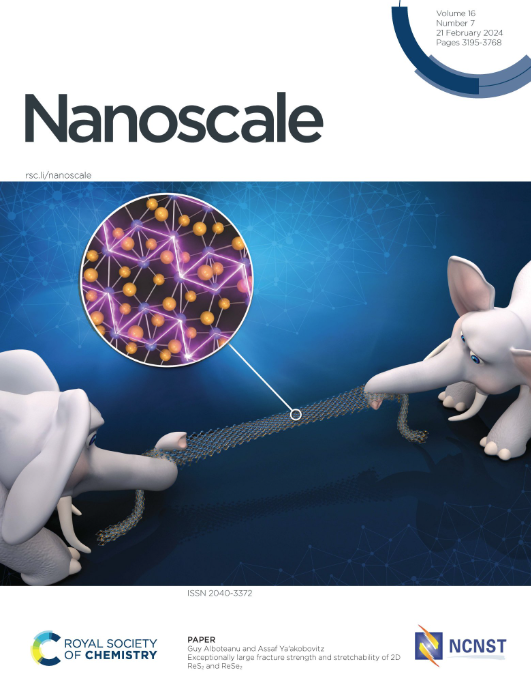In-Situ Growth of Layered 1T-MoS₂ onto Carbon Nanofibers as a Strategy Towards Advanced Hybrid Materials for Electrochemical Energy Storage and Catalysis
IF 5.8
3区 材料科学
Q1 CHEMISTRY, MULTIDISCIPLINARY
引用次数: 0
Abstract
Supercapacitors for electrochemical energy storage and electrocatalysts for hydrogen evolution reaction (HER) are pivotal in addressing global energy challenges. However, their widespread use is hindered by the limitations of the currently available functional materials. This study explores the in-situ hydrothermal growth of 1T-phase MoS₂ directly onto the surface of carbon nanofibers (CNFs), forming 3D hierarchical nanostructures with potential for both supercapacitor and HER applications. The effect of reaction time on the thickness of the 1T-MoS₂ outer layer is sistematically investigated, revealing a stepwise relationship between layer thickness and reaction time. The resulting 1T MoS₂/CNFs hybrids, with varying MoS₂ layer thicknesses, exhibit distinct specific capacitance behaviors under varying scan rates, due to differences in conductivity and ion diffusion distances. Post-electrochemical testing analysis reveals 1T-MoS₂ inherent instability, which, rather than transitioning to the 2H-phase, predominantly oxidizes to form molybdenum oxides. Despite this limitation, the hybrids demonstrate promising performance in HER electrocatalysis, with thicker MoS₂ layers offering more active sites, despite an unfavorable trade-off in conductivity. This study provides a mechanistic understanding of 1T-MoS₂/CNFs nanohybrids in electrochemical applications, highlighting the interplay bewteen MoS₂ phase composition, thickness and electrochemical performance. Our findings underscore both the potential and challenges in optimizing these nanohybrids for enhanced energy storage and hydrogen evolution, paving the way for future advancements in multifunctional energy materials.层状1T-MoS 2在纳米碳纤维上原位生长作为电化学储能和催化的先进杂化材料策略
电化学储能超级电容器和析氢反应电催化剂是解决全球能源挑战的关键。然而,由于现有功能材料的限制,它们的广泛使用受到阻碍。本研究探索了1t相MoS 2直接在碳纳米纤维(CNFs)表面的原位水热生长,形成具有超级电容器和HER应用潜力的三维分层纳米结构。系统地研究了反应时间对1T-MoS 2外层厚度的影响,揭示了层厚度与反应时间呈阶梯关系。由于电导率和离子扩散距离的差异,在不同扫描速率下,具有不同MoS 2层厚度的1T MoS 2 /CNFs杂化物表现出不同的比电容行为。电化学后测试分析揭示了1T-MoS 2固有的不稳定性,而不是过渡到2h相,主要氧化形成钼氧化物。尽管存在这些限制,但混合材料在HER电催化中表现出了良好的性能,更厚的MoS 2层提供了更多的活性位点,尽管电导率方面存在不利的权衡。这项研究提供了1T-MoS 2 /CNFs纳米杂化材料在电化学应用中的机理理解,突出了MoS 2相组成、厚度和电化学性能之间的相互作用。我们的研究结果强调了优化这些纳米混合材料的潜力和挑战,以增强能量储存和氢的演化,为多功能能源材料的未来发展铺平了道路。
本文章由计算机程序翻译,如有差异,请以英文原文为准。
求助全文
约1分钟内获得全文
求助全文
来源期刊

Nanoscale
CHEMISTRY, MULTIDISCIPLINARY-NANOSCIENCE & NANOTECHNOLOGY
CiteScore
12.10
自引率
3.00%
发文量
1628
审稿时长
1.6 months
期刊介绍:
Nanoscale is a high-impact international journal, publishing high-quality research across nanoscience and nanotechnology. Nanoscale publishes a full mix of research articles on experimental and theoretical work, including reviews, communications, and full papers.Highly interdisciplinary, this journal appeals to scientists, researchers and professionals interested in nanoscience and nanotechnology, quantum materials and quantum technology, including the areas of physics, chemistry, biology, medicine, materials, energy/environment, information technology, detection science, healthcare and drug discovery, and electronics.
 求助内容:
求助内容: 应助结果提醒方式:
应助结果提醒方式:


